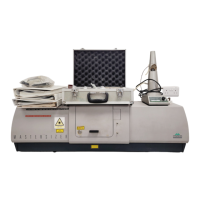The example above shows the result of transforming a skewed volume
distribution À to number Á.
Blending results
In some cases the sample size range may be so broad that it cannot be covered by a
single range lens but can be covered by the combination of two range lenses. The
results measured by the two range lenses can be blended to produce a result with
a broader size range.
The blending takes place within the overlapped region of the two size ranges. The
two results within this region are combined to give a smooth transaction of result
from one size range to the other.
In the following example the sample has a size ranging from 1 micron to about
3000 microns. When measured with the 300mm range lens of the Mastersizer S
the results above 900 microns are cut off; whereas with a 1000mm lens the results
below 4 microns are cut off. To get a result covering the entire sample size range,
the results measured with the two range lenses are blended.
%
30
Particle Diameter (µm.)
0
10
20
0.1 1.0 10.0 100.0 1000.010000.0
1
2
ILL 1874
Diameter of particles (µm)
Volume%
0
10
0
10
20
30
40
50
60
70
80
90
100
1.0
10.0 100.0 1000.0 10000.0
1
2
3
ILL 2798
CHAPTER 10
Getting Started
Page 10.8
MAN 0101

